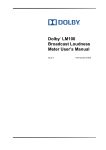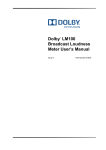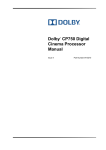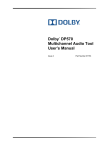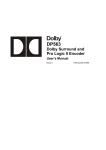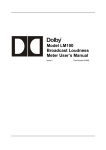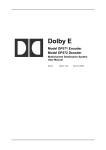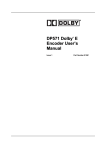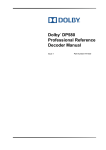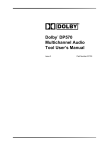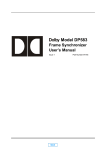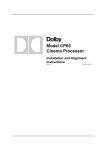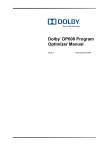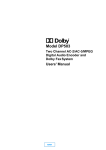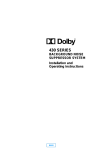Download Dolby Laboratories 425 Specifications
Transcript
Dolby Professional Reference Monitor Manual ® Issue 1 Model PRM-4200 Part Number 9110850 Dolby Laboratories, Inc. Corporate Headquarters Dolby Laboratories, Inc. 100 Potrero Avenue San Francisco, CA 94103‐4813 USA Telephone 415‐558‐0200 Fax 415‐863‐1373 www.dolby.com European Headquarters Dolby Laboratories, Inc. Wootton Bassett Wiltshire SN4 8QJ England Telephone 44‐1793‐842100 Fax 44‐1793‐842101 DISCLAIMER OF WARRANTIES: EQUIPMENT MANUFACTURED BY DOLBY LABORATORIES IS WARRANTED AGAINST DEFECTS IN MATERIALS AND WORKMANSHIP FOR A PERIOD OF ONE YEAR FROM THE DATE OF PURCHASE. THERE ARE NO OTHER EXPRESS OR IMPLIED WARRANTIES AND NO WARRANTY OF MERCHANTABILITY OR FITNESS FOR A PARTICULAR PURPOSE, OR OF NONINFRINGEMENT OF THIRD‐PARTY RIGHTS (INCLUDING, BUT NOT LIMITED TO, COPYRIGHT AND PATENT RIGHTS). LIMITATION OF LIABILITY: IT IS UNDERSTOOD AND AGREED THAT DOLBY LABORATORIES’ LIABILITY, WHETHER IN CONTRACT, IN TORT, UNDER ANY WARRANTY, IN NEGLIGENCE, OR OTHERWISE, SHALL NOT EXCEED THE COST OF REPAIR OR REPLACEMENT OF THE DEFECTIVE COMPONENTS OR ACCUSED INFRINGING DEVICES, AND UNDER NO CIRCUMSTANCES SHALL DOLBY LABORATORIES BE LIABLE FOR INCIDENTAL, SPECIAL, DIRECT, INDIRECT, OR CONSEQUENTIAL DAMAGES (INCLUDING, BUT NOT LIMITED TO, DAMAGE TO SOFTWARE OR RECORDED AUDIO OR VISUAL MATERIAL), COST OF DEFENSE, OR LOSS OF USE, REVENUE, OR PROFIT, EVEN IF DOLBY LABORATORIES OR ITS AGENTS HAVE BEEN ADVISED, ORALLY OR IN WRITING, OF THE POSSIBILITY OF SUCH DAMAGES. OPEN SOURCE SOFTWARE ATTRIBUTION: Boost: http://www.boost.org and http://www.boost.org/users/license.html Expat: http://sourceforge.net/projects/expat/ and http://www.jclark.com/xml/copying.txt Glib: http://library.gnome.org/devel/glib/ and http://www.gnu.org/licenses/lgpl.html LCM: http://code.google.com/p/lcm/ and http://www.gnu.org/licenses/lgpl.html Libconfig: http://www.hyperrealm.com/libconfig/ and http://www.gnu.org/licenses/lgpl.html Libjson: http://projects.snarc.org/libjson/ andhttp://www.gnu.org/licenses/lgpl‐2.1.html Libxml: http://xmlsoft.org/ and http://www.opensource.org/licenses/mit‐license.html QT: http://qt.nokia.com and http://www.gnu.org/licenses/lgpl‐2.1.html XMLRPC‐C: http://xmlrpc‐c.sourceforge.net/ and http://xmlrpc‐c.svn.sourceforge.net/viewvc/xmlrpc‐c/trunk/doc/COPYING?view=markup Zlib:http://zlib.net and http://zlib.net/zlib_license.html . Dolby and the double‐D symbol are registered trademarks of Dolby Laboratories. All other trademarks remain the property of their respective owners. © 2010 Dolby Laboratories. All rights reserved. ii Part Number 9110850 Issue 1 S10/23646 Dolby® Professional Reference Monitor Manual Regulatory Notices FCC NOTE: This equipment has been tested and found to comply with the limits for a Class A digital device, pursuant to Part 15 of the FCC rules. These limits are designed to provide reasonable protection against harmful interference when the equipment is operated in a commercial environment. This equipment generates, uses, and can radiate radio frequency energy and, if not installed and used in accordance with this instruction manual, may cause harmful interference to radio communications. Operation of this equipment in a residential area is likely to cause harmful interference in which case the user will be required to correct the interference at his own expense. Canada This Class A digital apparatus complies with Canadian ICES‐003. EU/EMC This equipment complies with the Electromagnetic Compatibility (EMC) Directive requirement of EN55103‐1:1996 and EN55103‐2:1996 when operated in accordance with this manual. WARNING: This is a class A product. In a domestic environment this product may cause radio interference, in which case the user may be required to take adequate measures. Important Safety Instructions 1. Read these instructions. 2. Keep these instructions. 3. Heed all warnings. 4. Follow all instructions. 5. Do not use this apparatus near water. 6. WARNING: To reduce the risk of fire or electric shock, do not expose this apparatus to rain or moisture. 7. Clean the metal frame and chassis only with a dry cloth. Clean the screen only with Read Right® Kleen & Dry™ CRT Screen Cleaning Pads. 8. Do not install near any heat sources such as radiators, heat registers, stoves, or other apparatus (including amplifiers)that produce heat. 9. No naked flame sources, such as lighted candles, should be placed on the apparatus. 10. Protect the power cord from being walked on or pinched, particularly at plugs, convenience receptacles, and the point where they exit from the apparatus. 11. Only use attachments/accessories specified by the manufacturer. 12. Unplug this apparatus during lightning storms or when unused for long periods of time. 13. Refer all servicing to qualified service personnel. Servicing is required when the apparatus has been damaged in any way, such as the power supply cord or plug is damaged, liquid has been spilled or objects have fallen into the apparatus, or the apparatus has been exposed to rain or moisture, does not operate normally, or has been dropped. 14. Do not expose the apparatus to dripping or splashing; no objects filled with liquids, such as vases, shall be placed on the apparatus. Dolby® Professional Reference Monitor Manual iii Regulatory Notices 15. CAUTION: Troubleshooting must be performed by a trained technician. To reduce the risk of electric shock, do not attempt to service this equipment unless you are qualified to do so. 16. Do not defeat the safety purpose of the polarized or grounding‐type plug. A polarized plug has two blades with one wider than the other. A grounding‐type plug has two blades and a third grounding prong. The wide blade or the third prong is provided for your safety. If the provided plug does not fit into your outlet, consult an electrician for replacement of the obsolete outlet. 17. This apparatus must be earthed (grounded) by connecting to a correctly wired and earthed power outlet. 18. Ensure that your mains supply is in the correct range for the input power requirement of the unit. 19. Ensure that any ventilation slots in the unit are not blocked or covered. 20. The mains power disconnect device for this unit is the plug‐in mains cord rather than the power switch. The mains cord must remain readily accessible for disconnecting mains power. 21. To avoid exposure to dangerous voltages and to avoid damage to the unit, do not connect the rear‐panel Ethernet port to telephone circuits. 22. As the colors of the cores in the mains lead may not correspond with the colored markings identifying the terminals in your plug, proceed as follows: • The green and yellow core must be connected to the terminal in the plug identified by the letter E, or by the earth symbol , or colored green, or green and yellow. • The blue core must be connected to the terminal marked with the letter N or colored black. • The brown core must be connected to the terminal marked with the letter L or colored red. 23. This apparatus must be earthed. Figure i‐1 CAUTION – Danger of explosion if battery is incorrectly replaced. Replace only with the same or equivalent type. Dispose of used batteries according to local law. PRODUCT END‐OF‐LIFE INFORMATION This product was designed and built by Dolby Laboratories to provide many years of service, and is backed by our commitment to provide high‐quality support. When it eventually reaches the end of its serviceable life, it should be disposed of in accordance with local or national legislation.For current information, please visit www.dolby.com/environment. Figure i‐2 Figure i‐4 iv This symbol that appears on the unit rear panel is intended to alert the user to the presence of uninsulated “dangerous” voltage within the product’s enclosure that maybe of sufficient magnitude to constitute a risk of electric shock to persons. Figure i‐3 Figure i‐5 This symbol is intended to alert the user to the presence of important safety operating and maintenance instructions. Dolby® Professional Reference Monitor Manual Regulatory Notices IMPORTANT SAFETY NOTICE This unit complies with safety standard EN60065 as appropriate. The unit shall not be exposed to dripping or splashing and no objects filled with liquids, such as coffee cups, shall be placed on the equipment. To ensure safe operation and to guard against potential shock hazard or risk of fire, the following must be observed: o Ensure that your mains supply is in the correct range for the input power requirement of the unit. o o o Ensure fuses fitted are the correct rating and type as marked on the unit. The unit must be earthed by connecting to a correctly wired and earthed power outlet. The power cord supplied with this unit must be wired as follows: Live—Brown Neutral—Blue Earth—Green/Yellow GB IMPORTANT – NOTE DE SECURITE Ce materiel est conforme à la norme EN60065. Ne pas exposer cet appareil aux éclaboussures ou aux gouttes de liquide. Ne pas poser dʹobjets remplis de liquide, tels que des tasses de café, sur lʹappareil. Pour vous assurer dʹun fonctionnement sans danger et de prévenir tout choc électrique ou tout risque dʹincendie, veillez à observer les recommandations suivantes. F o Le selecteur de tension doit être placé sur la valeur correspondante à votre alimentation réseau. o Les fusibles doivent correspondre à la valeur indiquée sur le materiel. o Le materiel doit être correctement relié à la terre. o Le cordon secteur livré avec le materiel doit être cablé de la manière suivante: Phase—Brun Neutre—Bleu Terre—Vert/Jaune WICHTIGER SICHERHEITSHINWEIS Dieses Gerät entspricht der Sicherheitsnorm EN60065. Das Gerät darf nicht mit Flüssigkeiten (Spritzwasser usw.) in Berührung kommen; stellen Sie keine Gefäße, z.B. Kaffeetassen, auf das Gerät. Für das sichere Funktionieren des Gerätes und zur Unfallverhütung (elektrischer Schlag, Feuer) sind die folgenden Regeln unbedingt einzuhalten: D o Der Spannungswähler muß auf Ihre Netzspannung eingestellt sein. o Die Sicherungen müssen in Typ und Stromwert mit den Angaben auf dem Gerät übereinstimmen. o Die Erdung des Gerätes muß über eine geerdete Steckdose gewährleistet sein. o Das mitgelieferte Netzkabel muß wie folgt verdrahtet werden: Phase—braun Nulleiter—blau Erde—grün/gelb NORME DI SICUREZZA – IMPORTANTE Questa apparecchiatura è stata costruita in accordo alle norme di sicurezza EN60065. Il prodotto non deve essere sottoposto a schizzi, spruzzi e gocciolamenti, e nessun tipo di oggetto riempito con liquidi, come ad esempio tazze di caffè, deve essere appoggiato sul dispositivo. Per una perfetta sicurezza ed al fine di evitare eventuali rischi di scossa êlettrica o dʹincendio vanno osservate le seguenti misure di sicurezza: o Assicurarsi che il selettore di cambio tensione sia posizionato sul valore corretto. I o Assicurarsi che la portata ed il tipo di fusibili siano quelli prescritti dalla casa costruttrice. o Lʹapparecchiatura deve avere un collegamento di messa a terra ben eseguito; anche la connessione rete deve avere un collegamento a terra. o Il cavo di alimentazione a corredo dellʹapparecchiatura deve essere collegato come segue: Filo tensione—Marrone Neutro—Blu Massa—Verde/Giallo AVISO IMPORTANTE DE SEGURIDAD Esta unidad cumple con la norma de seguridad EN60065. La unidad no debe ser expuesta a goteos o salpicaduras y no deben colocarse sobre el equipo recipientes con liquidos, como tazas de cafe. Para asegurarse un funcionamiento seguro y prevenir cualquier posible peligro de descarga o riesgo de incendio, se han de observar las siguientes precauciones: o Asegúrese que el selector de tensión esté ajustado a la tensión correcta para su alimentación. E o Asegúrese que los fusibles colocados son del tipo y valor correctos, tal como se marca en la unidad. o La unidad debe ser puesta a tierra, conectándola a un conector de red correctamente cableado y puesto a tierra. o El cable de red suministrado con esta unidad, debe ser cableado como sigue: Vivo—Marrón Neutro—Azul Tierra—Verde/Amarillo VIKTIGA SÄKERHETSÅTGÄRDER! Denna enhet uppfyller säkerhetsstandard EN60065. Enheten får ej utsättas för yttre åverkan samt föremål innehållande vätska, såsom kaffemuggar, får ej placeras på utrustningen. För att garantera säkerheten och gardera mot eventuell elchock eller brandrisk, måste följande observeras: o o o o Kontrollera att spänningsväljaren är inställd på korrekt nätspänning. Konrollera att säkringarna är av rätt typ och för rätt strömstyrka så som anvisningarna på enheten föreskriver. Enheten måste vara jordad genom anslutning till ett korrekt kopplat och jordat el‐uttag. El‐sladden som medföljer denna enhet måste kopplas enligt foljande: Fas—Brun Neutral—Blå Jord—Grön/Gul S BELANGRIJK VEILIGHEIDS‐VOORSCHRIFT: Deze unit voldoet aan de EN60065 veiligheids‐standaards. Dit apparaat mag niet worden blootgesteld aan vocht. Vanwege het risico dat er druppels in het apparaat vallen, dient u er geen vloeistoffen in bekers op te plaatsen. Voor een veilig gebruik en om het gevaar van electrische schokken en het risico van brand te vermijden, dienen de volgende regels in acht te worden genomen: o Controleer of de spanningscaroussel op het juiste Voltage staat. o Gebruik alleen zekeringen van de aangegeven typen en waarden. o Aansluiting van de unit alleen aan een geaarde wandcontactdoos. o De netkabel die met de unit wordt geleverd, moet als volgt worden aangesloten: Fase—Bruin Nul—Blauw Aarde—Groen/Geel NL Dolby® Professional Reference Monitor Manual v Table of Contents Chapter 1 Introduction .................................................................................................. 1 Chapter 2 Using the Professional Reference Monitor 2.1 Installing the PRM-4200 .....................................................................................................5 2.2 Remote Control Basics .......................................................................................................8 2.2.1 Display Control Section............................................................................................8 2.2.2 Display Mode Section ............................................................................................10 2.2.3 Remote Controller LCD Display.............................................................................12 2.2.4 Navigation Keys .....................................................................................................12 2.2.5 Numerical Keys......................................................................................................13 2.2.6 Brightness and Contrast Controls ..........................................................................13 2.2.7 Ethernet Port..........................................................................................................13 2.2.8 USB Ports ..............................................................................................................14 2.2.9 Rackmount or Tabletop Use ..................................................................................14 2.3 Editing the Reference and Emulation Parameters............................................................15 2.3.1 Editing the CRT Reference Parameters ................................................................15 2.3.2 Editing the Dynamic Reference Parameters..........................................................18 2.3.3 Editing the LCD, PDP, and Custom Emulation Parameters ..................................19 2.4 Configuring the System Parameters.................................................................................22 2.4.1 Configuring the Primaries ......................................................................................22 2.4.2 Configuring the White Point ...................................................................................24 2.4.3 Configuring the Gamma.........................................................................................25 2.4.4 Configuring the Gamut Control ..............................................................................26 2.4.5 Configuring the HD-SDI Link Mode........................................................................27 2.4.6 Configuring the HD-SDI Link Format .....................................................................28 2.4.7 Configuring Aspect Ratio and Scaling ...................................................................29 2.4.8 Configuring the Frame Rate Conversion ...............................................................30 2.4.9 Configuring the 2K Image Position ........................................................................31 2.4.10 Configuring the On-screen Display........................................................................32 2.4.11 Configuring the Calibration Reset..........................................................................33 2.4.12 Configuring the Remote Settings...........................................................................34 2.4.13 Configuring the System Utilities.............................................................................35 2.4.14 System Menus .......................................................................................................43 2.5 Saving and Loading Custom Presets ...............................................................................44 Appendix A PRM-4200 Maintenance A.1 Replacing the Filter ..........................................................................................................45 A.2 Cleaning the Monitor Screen ............................................................................................47 Appendix B Dolby PRM-4200 Specifications ............................................................ 49 Index.............................................................................................................................. 51 Dolby® Professional Reference Monitor Manual vii List of Figures Figure 1-1 PRM-4200 Front Panel.......................................................................................................... 1 Figure 1-2 PRM-4200 Rear Panel .......................................................................................................... 2 Figure 1-3 PRM-4200 Rear-Panel Connectors (Enlarged and Labeled) ................................................ 2 Figure 1-4 Remote Front Panel .............................................................................................................. 3 Figure 1-5 Remote Rear Panel ............................................................................................................... 3 Figure 2-1 PRM-4200 Ventilation Requirements .................................................................................... 5 Figure 2-2 Connect Inputs and Outputs.................................................................................................. 6 Figure 2-3 Connecting the Remote Rear-Panel Ports ............................................................................ 6 Figure 2-4 Connect AC Power and Turn On Monitor.............................................................................. 7 Figure 2-5 Searching for Monitor Screen ............................................................................................... 7 Figure 2-6 CRT Reference Mode Status 1 Screen (HD-SDI Input Source)............................................ 7 Figure 2-7 Remote Front Panel .............................................................................................................. 8 Figure 2-8 Control Functions .................................................................................................................. 8 Figure 2-10 Display Mode Functions ...................................................................................................... 10 Figure 2-11 Navigation Keys................................................................................................................... 12 Figure 2-12 Numerical Keypad ............................................................................................................... 13 Figure 2-13 CRT Reference Mode Status Screen .................................................................................. 15 Figure 2-14 Accessing the CRT Reference Parameters......................................................................... 15 Figure 2-15 CRT Mode: Input Screen..................................................................................................... 16 Figure 2-16 Custom Video Range Screen .............................................................................................. 16 Figure 2-17 CRT Mode: Brightness Screen............................................................................................ 17 Figure 2-18 CRT Mode: Contrast Screen ............................................................................................... 17 Figure 2-19 CRT Mode: Max Luminance Screen ................................................................................... 18 Figure 2-20 Dynamic Reference Mode Status Screen ........................................................................... 18 Figure 2-21 Dynamic Mode: Max Luminance Screen............................................................................. 19 Figure 2-22 LCD Emulation Mode Status Screen................................................................................... 20 Figure 2-23 LCD Mode: Input Screen ..................................................................................................... 20 Figure 2-24 LCD Mode: Input Format/Video Range/Custom Screen ..................................................... 21 Figure 2-25 System/Primaries Screen .................................................................................................... 22 Figure 2-26 System/Primaries/Custom Primaries Screen ...................................................................... 22 Figure 2-27 Custom Primaries Limits...................................................................................................... 23 Figure 2-28 System/White Point Screen................................................................................................. 24 Figure 2-29 System/White Point/Custom White Point ........................................................................... 24 Figure 2-30 System/Gamma Screen ..................................................................................................... 25 Figure 2-31 System/Gamma/Custom Gamma Screen ........................................................................... 25 Figure 2-32 System/Gamut Control Screen............................................................................................ 26 Figure 2-33 System/HD-SDI Link Mode Screen ..................................................................................... 27 Figure 2-34 System/HD-SDI Link Format Screen ........................................................................................ 28 Figure 2-35 Aspect Ratio and Scaling Screen ........................................................................................ 29 Figure 2-36 System/Frame Rate Conversion Screen.............................................................................................. 30 Figure 2-37 System/2K Image Position Screen....................................................................................................... 31 Figure 2-38 System/On-Screen Display Parameters.............................................................................. 32 Figure 2-39 System/Calibration/Reset Screen........................................................................................ 33 Figure 2-40 System/Calibration/Reset/Manual Calibration Screen......................................................... 33 Figure 2-41 System/Calibration/Reset/Factory Reset Screen ................................................................ 34 Figure 2-42 Remote Settings Screen...................................................................................................... 34 Figure 2-43 System/Utilities Screen........................................................................................................ 35 Figure 2-44 System/Utilities/Monitor IP Configuration Screen................................................................ 36 Dolby® Professional Reference Monitor Manual ix List of Figures Figure 2-45 Figure 2-46 Figure 2-47 Figure 2-48 Figure 2-49 Figure 2-50 Figure 2-51 Figure 2-52 Figure 2-53 Figure 2-54 Figure 2-55 Figure 2-56 Figure 2-57 Figure 2-58 Figure 2-59 Figure 2-60 Figure 2-61 Figure 2-62 Figure A-1 Figure A-2 Figure A-3 Figure A-4 x System/Utilities/About This PRM-4200 Screen ................................................................... 36 System/Utilities/Load LUT Screen....................................................................................... 37 Select a File to Load Screen ............................................................................................... 37 Select Where to Load Screen.............................................................................................. 38 Load LUTs Confirmation Screen ......................................................................................... 38 System/Utilities/Load LUT Screen....................................................................................... 39 Select a File to Load Screen ............................................................................................... 39 Select Where to Load Screen.............................................................................................. 40 Load LUTs Confirmation Screen ......................................................................................... 40 Gamma/LUTs Screen Displays Loaded 1D LUT................................................................. 40 Software Upgrade Screen ................................................................................................... 41 USB Device Screen............................................................................................................. 41 Select a File to Load Screen ............................................................................................... 42 Software Upgrade Confirmation Screen.............................................................................. 42 Upgrade Is in Progress Screen ........................................................................................... 42 Save Preset Screen............................................................................................................. 44 Preset Name Screen ........................................................................................................... 44 Load Preset Screen............................................................................................................. 44 Remove Filter Door ............................................................................................................. 45 Remove Filter ...................................................................................................................... 46 Install New Filter .................................................................................................................. 46 Reinstall Filter Door ............................................................................................................. 46 Dolby® Professional Reference Monitor Manual Chapter 1 Introduction Welcome to Dolby® professional video! The Dolby Professional Reference Monitor (PRM‐4200) is designed for the postproduction, film, and television broadcast industries. The PRM‐4200 has a resolution of 1,920 × 1,080 pixels and a refresh rate of 120 Hz, utilizing Dolby Laboratories’ dual‐modulation technology. This enables the 42‐inch (diagonal) flat‐panel display to deliver extended dynamic range and reveal true and deep blacks with higher contrast across its entire color spectrum. The PRM‐4200 complies with the industry standard color primaries (ITU‐R BT.709 [also referred to as Rec. 709], DCI P3, SMPTE‐C, and EBU) and accepts the CIE 1931 XYZ color space. We designed the PRM‐4200 to equal or exceed the performance characteristics of a reference CRT display. In addition, the PRM‐4200 can emulate consumer LCD and plasma display panel (PDP) displays, providing the colorist with an immediate quality control reference point while in the grading suite. With the use of custom 3D lookup tables (LUTs), the PRM‐4200 can also emulate any other display or film stock. Figure 1‐1 Power and status LED Figure 1-1 PRM-4200 Front Panel Dolby® Professional Reference Monitor Manual 1 Introduction Figure 1‐2 Input/output connectors (see blowup in Figure 1-3) Filter door Power switch Power port Figure 1-2 PRM-4200 Rear Panel Figure 1‐3 Remote control connector (Ethernet) External network connector (Ethernet) DVI input Audio sync output HD-SDI A & B inputs A HD-SDI A & B outputs Figure 1-3 2 PRM-4200 Rear-Panel Connectors (Enlarged and Labeled) Dolby® Professional Reference Monitor Manual Introduction You operate the PRM‐4200 using the Dolby Remote Control. You can use the Remote on the desktop or in a standard 19‐inch equipment rack. For complete details on the Remote, see Chapter 2. Figure 1‐4 Brightness/Contrast controls USB ports Display control keys and LEDs Figure 1-4 Figure 1‐5 Display mode keys User display/navigation area Numerical keypad USB port Remote Front Panel Power port Figure 1-5 Ethernet port (connects to monitor) Remote Rear Panel Dolby® Professional Reference Monitor Manual 3 Chapter 2 Using the Professional Reference Monitor This chapter explains how to use the Dolby® PRM‐4200. 2.1 Installing the PRM-4200 To install the Dolby® PRM‐4200: 1. Position the PRM‐4200 in a well‐ventilated area, at a minimum of 12 inches from a side wall and 12 inches from a rear wall. In addition, if you install the PRM‐4200 in any type of enclosure, air should flow into the enclosure at a minimum of 200 cubic feet per minute (CFM) air at 25°C. Be sure that no exhaust air recirculates to the intake on the rear panel (see Figure 2‐1). Note: We recommend that you maintain a room temperature near 25°C. Figure 2‐1 Exhaust Exhaust Intake Sid ew all 12 inches 12 inches Rear wall Figure 2-1 PRM-4200 Ventilation Requirements Dolby® Professional Reference Monitor Manual 5 Using the Professional Reference Monitor 2. Connect your required inputs and outputs on the PRM‐4200 rear panel, as shown in Figure 2‐2. Figure 2‐2 To Remote Control (Ethernet) To external network (Ethernet) DVI in Audio sync out HD-SDI A & B in A HD-SDI A & B out Figure 2-2 • Use the HD‐SDI A input for single‐link formats. • Use the HD‐SDI A and B inputs for dual‐link formats. Note: 3. Connect Inputs and Outputs To use the HD‐SDI inputs, you need to configure the HD‐SDI link mode and HD‐SDI link format parameters, as described in Section 2.4.5 and Section 2.4.6. Connect the Remote Control to the PRM‐4200 using the provided Ethernet cable, then connect the provided power supply to an AC power source and connect the Remote to the DC side of the power supply, as shown in Figure 2‐3. Figure 2‐3 To monitor (Ethernet) To power AC Ad Figure 2-3 6 t Connecting the Remote Rear-Panel Ports Dolby® Professional Reference Monitor Manual Installing the PRM-4200 4. Connect the PRM‐4200 power cable to an AC power source, then press the power switch to turn on the monitor, as shown in Figure 2‐4. Figure 2‐4 Press power switch Connect AC power Figure 2-4 Connect AC Power and Turn On Monitor While the Remote is booting, the Dolby logo appears on its user display, and then a message indicates that it is searching for a connected monitor, as shown in Figure 2‐5. Figure 2‐5 Figure 2-5 Searching for Monitor Screen When the Remote recognizes the PRM‐4200, the Dolby logo appears, and then the CRT Reference Mode Status 1 screen appears, as shown in Figure 2‐6 for an HD‐SDI 3G Level A input. Figure 2‐6 SMPTE timecode Current operating mode Input status Output status Tab menu Press right arrow on Remote to highlight tab and display timecode-only screen Figure 2-6 CRT Reference Mode Status 1 Screen (HD-SDI Input Source) CRT Reference mode is the default PRM‐4200 operating mode. The other operating modes (Dynamic Reference, LCD, PDP, Custom 1, Custom 2) display similar information in their respective status screens. Tab menus provide access to the appropriate parameters and other information as you move from screen to screen. All of the operating modes and their corresponding parameters are described in detail later in this chapter. Section 2.2 shows you how to use the Remote to operate the PRM‐4200. Dolby® Professional Reference Monitor Manual 7 Using the Professional Reference Monitor 2.2 Remote Control Basics We designed the Remote for use on a desktop or in a standard 19‐inch equipment rack (rack tray for mounting included). You can access the most frequently used functions through front‐panel buttons, while additional functions are accessible in menus that appear on the user display. There are no onscreen display (OSD) menus provided on the monitor itself, but you can use the Remote to access action‐safe and title‐safe markers and selected pixels on the PRM‐4200 screen. The Remote front panel provides the following sections of logically grouped functions, as shown in Figure 2‐7: • Display control • Display mode • User display and navigation • Numerical keypad for entries and presets Each of these sections contain function‐related keypads, which are easily accessible in low light conditions. You press on a key to activate the respective function. Some of the keys illuminate when activated. The BRIGHTNESS and CONTRAST controls are located above the keypad. Figure 2‐7 Brightness/Contrast USB Display mode Display control Figure 2-7 User display/Navigation Numerical Keypad USB Remote Front Panel Following is an overview of each function area on the Remote. 2.2.1 Display Control Section Three LEDs appear at the top of the Display Control section: CAL, CHANNELS ALL, and MARKERS OFF. Three keys below each LED control the corresponding functions. Following is a description of each LED and its respective function keys. Figure 2‐8 CAL CHANNELS ALL Figure 2-8 8 MARKERS OFF Control Functions Dolby® Professional Reference Monitor Manual Remote Control Basics Cal This red LED: Table 2-1 • Illuminates when you change the default brightness, contrast, or RGB gain calibration settings • Turns off when you restore the default calibration settings Cal Key Descriptions Key BYPASS MONO B/C LOCK Function Illumination Notes Bypasses user‐customized brightness, contrast, and RGB gain settings only Yellow when enabled, turns Press this key to return the off when disabled PRM‐4200 to its original default calibration settings (if you modified these settings). Specifies a monochromatic Yellow when enabled, turns display for the currently off when disabled enabled channel (R,G, or B) Enables/disables the rotary Yellow when enabled, turns knobs for BRIGHTNESS and off when disabled CONTRAST controls Channels All ALL Table 2-2 Key R G B This blue LED: • Illuminates when all three color channels (red, green, and blue) are enabled • Turns off when you select a single color channel (red, green, or blue) Channels All Key Descriptions Function Selects red channel only, disables green and blue channels; when disabled, returns the PRM‐4200 to all color channels on Selects green channel only, disables red and blue channels; when disabled, returns the PRM‐4200 to all color channels on Illumination Notes Yellow when enabled, turns You can select only one color off when disabled channel at a time. Yellow when enabled, turns You can select only one color off when disabled channel at a time. Selects blue channel only, Yellow when enabled, turns You can select only one color disables red and green off when disabled channel at a time. channels; when disabled, returns the PRM‐4200 to all color channels on Dolby® Professional Reference Monitor Manual 9 Using the Professional Reference Monitor Markers Off This blue LED: Table 2-3 Illuminates when all the onscreen markers are deactivated • Turns off when one of the three onscreen markers is activated Markers Off Key Descriptions Key CURSOR • Function Illumination Shows pixel cursor on the PRM‐4200 screen when enabled Notes Yellow when enabled, turns The Pixel Cursor screen appears on the off when disabled Remote, as shown in the example in Figure 2‐9. In this screen, you can enter x/y coordinates to position the pixel cursor on the PRM‐4200 screen. Use the arrow keys or the numerical keypad to adjust the values. Press ENTER to toggle between x and y. Figure 2‐9 Figure 2-9 Pixel Cursor Screen ACTION Shows action‐safe markers Yellow when enabled, turns on the PRM‐4200 screen off when disabled when enabled TITLE Shows title‐safe markers on Yellow when enabled, turns the PRM‐4200 screen when off when disabled enabled 2.2.2 Display Mode Section The Display Mode section provides access to the PRM‐4200 reference, emulation, and operating modes. You activate each of these modes by pressing its corresponding key, which illuminates in yellow. Following is a description of the Display Mode function keys. Figure 2‐10 Reference modes Operating modes Emulation modes Figure 2-10 Display Mode Functions 10 Dolby® Professional Reference Monitor Manual Remote Control Basics Reference Mode Keys The reference modes provide highly accurate colorimetry and gray‐scale performance. They allow a user to modify display related parameters only (brightness, contrast, and maximum luminance), and to toggle between two groups of display related settings. We created these modes for the colorist, as the main work areas. There are two reference modes: CRT REFERENCE This mode provides a maximum luminance of 120 cd/m2, continuously variable from 40 cd/m2. DYNAMIC REFERENCE This mode provides a maximum luminance of 600 cd/m2, continuously variable from 40 cd/m2. Emulation Mode Keys The emulation modes use 3D Lookup Tables (LUTs) to duplicate the colorimetry of another display device. There are four emulation modes: CUSTOM 1 CUSTOM 2 These modes apply user‐loaded 3D LUTs to emulate the properties of the desired display devices. For information on loading custom LUTs, see Section 2.4.13. LCD (Liquid Crystal Display) This mode emulates the properties of an LCD. PDP (Plasma Display Panel) This mode emulates the properties of a Plasma display. The LCD and PDP modes are preloaded on the system. Operating Mode Keys The operating modes provide access to the PRM‐4200 settings. There are three operating modes: EDIT This mode allows you to edit reference mode and emulation mode parameters, as described in Section 2.3. SYSTEM This mode allows you to access and configure the PRM‐4200 global settings (those settings that are not accessible using the EDIT key). Typically, you specify the system settings at the beginning of a session, and these settings do not change during the session. For complete details on the SYSTEM key functions, see Section 2.4. Dolby® Professional Reference Monitor Manual 11 Using the Professional Reference Monitor STATUS The STATUS key displays the PRM‐4200 core operating parameters for the selected reference or emulation mode. (See the example for CRT Reference mode in Figure 2‐6.) It also provides access to a SMPTE timecode display. 2.2.3 Remote Controller LCD Display The Remote LCD user display provides screens and menus that allow you to access, edit, and configure many PRM‐4200 parameters. 2.2.4 Navigation Keys You use the navigation keys to move through menu options, tabs, and dialog boxes that appear on the Remote user display. Figure 2‐11 Figure 2-11 Navigation Keys 12 • The up and down arrow keys illuminate in yellow when you use them to enter data in dialog boxes. • The left and right arrow keys illuminate in yellow when you use them to adjust values in slider display screens. • You press the ENTER key to activate a data entry field, to confirm or save parameter changes, and to exit some screens. When you press this key, it illuminates in yellow. • You can use the DIM key to dim the Remote LED and LCD preset brightness levels. When you press DIM, the system uses the levels set in the Remote Settings screen, as shown in Figure 2‐42. • You can use the ESC key to exit a dialog box without saving changes. However, if you make changes in a dialog box and press ENTER before pressing ESC, the system saves the changes. Dolby® Professional Reference Monitor Manual Remote Control Basics 2.2.5 Numerical Keys Figure 2‐12 Figure 2-12 Numerical Keypad You use the numerical keys to enter values in the Remote data entry fields. You can use the backspace key in the lower‐left corner to delete characters from right to left. Using the Numerical Keys to Save Custom Presets You can also use the numerical keys to save and load custom presets, as described in Section 2.5. Each preset saves the current state of all PRM‐4200 parameters. You can configure many of these parameters using the Remote EDIT and SYSTEM menus. For more information on configuring these parameters, see Section 2.3 and Section 2.4. 2.2.6 Brightness and Contrast Controls The BRIGHTNESS control sets the black level. It adds or subtracts an offset in the red, green, and blue channels. When adjusting this control, the black picture content should appear as true black on the PRM‐4200. After setting the brightness correctly, you should set the contrast for comfortable viewing brightness. The CONTRAST control sets the white level. It applies a scale factor (gain) to the red, green, and blue channels. This affects the luminance (proportional to intensity) that the system reproduces for a full white input signal. You can lock the BRIGHTNESS and CONTRAST control knobs by pressing the B/C LOCK key in the Control area on the Remote. This lock prevents accidental changes to the settings. The B/C LOCK key illuminates in yellow when activated. The BRIGHTNESS and CONTRAST control knobs have dedicated blue LEDs. The respective LED illuminates when you turn a knob out of the default center detent position. The LED is off when a knob is in the center detent position. 2.2.7 Ethernet Port The Remote has one RJ45 port for connecting to the PRM‐4200 via a dedicated point‐to‐point network connection. The Remote communicates with the PRM‐4200 through this 10/100Base‐T connection using the provided Cat. 5e twisted‐pair cable. The transport and network layers are TCP/IP. The Remote IP address is statically configured at the factory; no user intervention is required for the Remote to communicate with the PRM‐4200. Dolby® Professional Reference Monitor Manual 13 Using the Professional Reference Monitor 2.2.8 USB Ports The Remote has three USB 2.0 compliant ports. Two are located on the left side of the Remote front panel (oriented vertically), and one is located on the right side panel. The USB ports are provided to connect memory devices. You can insert USB memory devices to save 1D and 3D LUTs (to the PRM‐4200, not on the Remote) and to upgrade the system. 2.2.9 Rackmount or Tabletop Use You can use the Remote on a tabletop or in a standard 19‐inch equipment rack. When rackmounted, the Remote requires two standard rackspaces. In addition, the Remote requires the included rack tray for rackmounting. Rubber feet on the bottom of the unit provide friction when the Remote is used on a tabletop. 14 Dolby® Professional Reference Monitor Manual Editing the Reference and Emulation Parameters 2.3 Editing the Reference and Emulation Parameters You can edit the PRM‐4200 reference and emulation parameters using the Remote. Table 2‐4 shows the edit mode parameters for the CRT Reference and Dynamic Reference modes, and the Custom 1, Custom 2, LCD, and PDP emulation modes. Table 2-4 CRT Reference Mode and Emulation Mode Edit Parameters Dynamic Custom 1 & 2 Input Format Input Format Input Format Video Range Video Range Brightness Brightness Contrast Contrast Luminance Luminance Note: 2.3.1 Video Range LCD PDP Input Format Input Format Video Range Video Range You can activate only one mode at a time by pressing its respective key. When you press a key, it illuminates in yellow. Enabling one mode disables any other mode. Editing the CRT Reference Parameters To edit the CRT reference parameters: 1. Press the CRT REFERENCE key, then press the STATUS key. The CRT Reference Mode status screen displays the current input and output formats, as shown in the example in Figure 2‐13. Figure 2‐13 Figure 2-13 CRT Reference Mode Status Screen 2. Figure 2‐14 Press the EDIT key, as shown in Figure 2‐14. Press EDIT Figure 2-14 Accessing the CRT Reference Parameters Dolby® Professional Reference Monitor Manual 15 Using the Professional Reference Monitor The key illuminates in yellow and the CRT Mode: Input screen appears with Input Format and Video Range parameters, as shown in Figure 2‐15. This is the first CRT reference editing screen. The Input tab at the bottom‐left side of the screen is highlighted, indicating it is the active menu selection. Figure 2‐15 Active menu Figure 2-15 CRT Mode: Input Screen 3. To change a current setting, press the up/down arrow keys to highlight the desired parameter, and then press ENTER. If you select Custom, the Custom Video Range dialog box appears, as shown in Figure 2‐16. Figure 2‐16 Figure 2-16 Custom Video Range Screen In this screen, you can enter the desired video range settings by using the arrow keys to select each field and pressing ENTER to activate the field. The up/down arrow keys illuminate, indicating you can use these to increase/decrease each value. To scroll up and down through the range of values, press and hold the arrow keys. Alternatively, you can use the numeric keypad to directly enter the desired value. To save your entries, press ENTER again. You can display another CRT reference screen by pressing the down arrow key until you activate the tab menu, then press the right/left arrow keys or the EDIT key. Caution: The system saves your changes in an edit screen only when you press ENTER. You can quit any dialog box by pressing the ESC key. 16 Dolby® Professional Reference Monitor Manual Editing the Reference and Emulation Parameters 4. Press the down arrow key to activate the tab menu, then press the right arrow key (or the EDIT key). The CRT Mode: Brightness screen appears with a slider display, which indicates the current brightness setting, as shown in Figure 2‐17. Figure 2‐17 Figure 2-17 CRT Mode: Brightness Screen 5. To change the current brightness setting: • If the B/C LOCK (third key below CAL) is illuminated, press this key to unlock the brightness control. This lock prevents accidental changes to the brightness setting. • Turn the BRIGHTNESS control knob (located above the numeric keypad) to move the slider to the desired value, and then press ENTER. • To lock in your new settings, press the B/C LOCK key. When you change the default brightness setting, the LED next to its control knob illuminates in blue. 6. Press the right arrow key (or the EDIT key). The CRT Mode: Contrast screen appears with a slider display, which indicates the current contrast setting, as shown in Figure 2‐18. Figure 2‐18 Figure 2-18 CRT Mode: Contrast Screen 7. To change the current contrast setting: • If the B/C LOCK (third key below CAL) is illuminated, press this key to unlock the contrast control. This lock prevents accidental changes to the contrast setting. • Turn the CONTRAST control knob (located above the numeric keypad) to move the slider to the desired value, and then press ENTER. • To lock in your new settings, press the B/C LOCK key. Dolby® Professional Reference Monitor Manual 17 Using the Professional Reference Monitor When you change the default contrast setting, the LED next to its rotary control knob illuminates in blue. 8. Press the right arrow key (or the EDIT key). The CRT Mode: Max Luminance screen appears. In this screen, you can change the maximum luminance value for the PRM‐4200, as shown in Figure 2‐19. Figure 2‐19 Figure 2-19 CRT Mode: Max Luminance Screen 9. 2.3.2 Press ENTER twice to activate the slider, then use the illuminated left and right arrow keys to change your setting, and press ENTER again to save. Editing the Dynamic Reference Parameters Dynamic Reference mode moves the display into a higher dynamic range. In this mode, the black level remains constant as the allowable maximum luminance level increases. The white point and primary locations also remain constant. 1. Press the DYNAMIC REFERENCE mode key. If you are already in edit mode, the input format and video range parameters appear, which are the same as in the CRT Reference Mode status screen. If you are not in edit mode, press the STATUS key to display the Dynamic Reference Mode status screen, as shown Figure 2‐20, then press the EDIT key to display the corresponding input format and video range parameters. Figure 2‐20 Figure 2-20 Dynamic Reference Mode Status Screen 18 Dolby® Professional Reference Monitor Manual Editing the Reference and Emulation Parameters Dynamic Mode Input Format, Video Range, Brightness, and Contrast These Dynamic Reference mode parameters and their respective screens are identical to those in the CRT Reference Mode (described in Section 2.3.1). Dynamic Mode Maximum Luminance The Dynamic Reference mode maximum luminance (600 cd/m2) is greater than in CRT Reference mode (120 cd/m2). In this mode, you can change the maximum luminance value using the slider (see Figure 2‐21), as described previously for CRT Reference mode. Figure 2‐21 Figure 2-21 Dynamic Mode: Max Luminance Screen White Point Dependency In Dynamic mode, the maximum attainable luminance changes when you adjust the white point. For information on setting the white point, see Figure 2‐28. 2.3.3 Editing the LCD, PDP, and Custom Emulation Parameters These modes emulate other devices, as follows: • LCD mode uses a factory supplied 3D LUT that is representative of consumer LCD displays. • PDP mode uses a factory supplied 3D LUT that is representative of consumer plasma displays. • Custom mode 1 and Custom mode 2 use custom 3D LUTs to provide user‐specific display emulation. For information on loading custom LUTs, see Load LUTs on page 37. Dolby® Professional Reference Monitor Manual 19 Using the Professional Reference Monitor The parameters for all the emulation modes are identical. To edit these parameters: 1. Press the desired emulation mode key (LCD, PDP, CUSTOM 1, or CUSTOM 2), and then press the STATUS key. The respective status screen displays the current input and output formats, as shown in the example in Figure 2‐22 for the LCD Emulation Mode status screen. Figure 2‐22 Figure 2-22 LCD Emulation Mode Status Screen 2. Press the EDIT key. The Input Format and Video Range parameters appear for the respective mode, as shown in the example in Figure 2‐23 for the LCD Mode: Input screen. Figure 2‐23 Figure 2-23 LCD Mode: Input Screen 3. To change the current setting, press the up and down arrow keys to highlight the desired parameter, and then press ENTER. If you are already in edit mode, but want to edit these parameters for a different emulation mode, press the desired emulation key to display these parameters for the respective mode. You cannot adjust the brightness, contrast, and luminance parameters in the emulation modes. 20 Dolby® Professional Reference Monitor Manual Editing the Reference and Emulation Parameters 4. To specify a custom video range, use the arrow keys to select Custom, then press ENTER. The Custom Video Range dialog box appears, as shown in Figure 2‐24. Figure 2‐24 Figure 2-24 LCD Mode: Input Format/Video Range/Custom Screen In this screen, you can use the arrow keys to navigate to the desired field and press ENTER to activate that field. The up/down arrow keys illuminate, indicating that you can use these for data entry. 5. Use the arrow keys or the numeric keypad to specify the desire value, and press ENTER again to save your entries. To return to the LCD Mode: Input screen, press ESC. Dolby® Professional Reference Monitor Manual 21 Using the Professional Reference Monitor 2.4 Configuring the System Parameters You configure the PRM‐4200 system parameters using the Remote. The system parameters apply to global operations and functions. Most of these parameters apply to the entire monitor system. However, some of the system parameters apply only to CRT Reference mode or Dynamic Reference mode. 2.4.1 Configuring the Primaries To configure these parameters: 1. Press the SYSTEM key to activate the tab menu, then use the arrow keys (or the SYSTEM key) to move to the Primaries tab. The Primaries screen appears, as shown in Figure 2‐25. The primaries represent the chromaticity coordinates for the RGB and YCbCr inputs. You can change the current setting by pressing the up/down arrow keys to highlight the desired parameter, and then pressing ENTER. Figure 2‐25 Figure 2-25 System/Primaries Screen If you select Custom, a dialog box appears where you can specify the desired primary CIE x and y coordinates for red, green, and blue, as shown in Figure 2‐26. Figure 2‐26 Figure 2-26 System/Primaries/Custom Primaries Screen Note: 22 The Primaries tab is inaccessible when the input is XYZ or Lu’v’, or when an emulation mode is active. In such cases, the primaries are absolute. (Dolby Lu’v’ is a new video format developed by Dolby Laboratories for potential future video applications.) Dolby® Professional Reference Monitor Manual Configuring the System Parameters 2. Use the arrow keys, and press ENTER to activate a field, then use the arrow keys or the keypad to change a setting, and press ENTER again to save. • A single up‐arrow key press increases the current value by 0.0001. • A single down‐arrow key press of decreases the current value by 0.0001. • Pressing and holding the up arrow for more than 1.5 seconds increases values continuously by 0.001. • Pressing and holding the down arrow for more than 1.5 seconds decreases values continuously by 0.001. Note: If a setting is invalid, the corresponding x and y coordinates are outlined in red and you must change them to compatible values before saving. Following is the valid range of values for custom primaries (see Figure 2‐27): Red (x = 0.68, y = 0.32) (x = 0.6197, y = 0.3738) (x = 0.5928, y = 0.2772) Green (x = 0.265, y = 0.69) (x = 0.3731, y = 0.5936) (x = 0.2337, y = 0.5183) Blue (x = 0.15, y = 0.06) (x = 0.202, y = 0.0855) (x = 0.1605, y = 0.1175) Figure 2‐27 0.7 0.6 0.5 y 0.4 y 0.3 0.2 0.1 0 0.1 0.2 0.3 0.4 x x 0.5 0.6 0.7 0.8 Figure 2-27 Custom Primaries Limits Dolby® Professional Reference Monitor Manual 23 Using the Professional Reference Monitor 2.4.2 Configuring the White Point To configure this parameter: 1. Press the SYSTEM key to activate the tab menu, then use the arrow keys (or the SYSTEM key) to move to the White Point tab. The White Point screen appears. For Dynamic Reference mode, a note appears in this screen, reminding you that the maximum attainable luminance changes with the white point setting, as shown in Figure 2‐28. This note does not appear in CRT Reference mode. Figure 2‐28 Figure 2-28 System/White Point Screen The white point sets the chromaticity of white for the RGB and YCbCr inputs. You can change the current setting by pressing the up and down arrow keys, and then pressing the ENTER key. If you select Custom, a dialog box appears, where you can specify the desired white point CIE x and y coordinates, as shown in Figure 2‐29. Figure 2‐29 Figure 2-29 System/White Point/Custom White Point Note: 24 The White Point tab is inaccessible when the input is XYZ or Lu’v’, or when an emulation mode is active. In such cases, the white point is absolute. (Dolby Lu’v’ is a new video format developed by Dolby Laboratories for potential future video applications.) Dolby® Professional Reference Monitor Manual Configuring the System Parameters 2. 2.4.3 Use the up/down arrow keys, and press ENTER to activate the desired slider, then use the left/right arrow keys to change a setting, and press ENTER again to save. • A single right‐arrow key press increases the current value by 0.0001. • A single left‐arrow key press decreases the current value by 0.0001. • Pressing and holding the right arrow for more than 1.5 seconds increases values continuously by 0.001. The maximum value is 0.5. • Pressing and holding the left arrow for more than 1.5 seconds decreases values continuously by 0.001. The minimum value is 0.2. Configuring the Gamma To configure this parameter: 1. Press the SYSTEM key to activate the tab menu, then use the arrow keys (or the SYSTEM key) to move to the Gamma/LUTs tab. The Gamma screen appears, with Pure Gamma and Custom LUT parameters, as shown in Figure 2‐30. Figure 2‐30 Figure 2-30 System/Gamma Screen In this screen, you can use the arrow keys to specify a pure gamma or a 1D custom LUT gamma that was loaded from a USB storage device. (See Loading a 1D LUT on page 39.) Press the ENTER key to save. If you select Custom, a dialog box appears, where you can specify the desired gamma, as shown in Figure 2‐31. Figure 2‐31 Figure 2-31 System/Gamma/Custom Gamma Screen Note: The Gamma/LUTs tab is inaccessible when the input is Lu’v’, or when an emulation mode is active. In such cases, the gamma is absolute. (Dolby Lu’v’ is a new video format developed by Dolby Laboratories for potential future video applications.) Dolby® Professional Reference Monitor Manual 25 Using the Professional Reference Monitor 2. 2.4.4 Use the arrow keys or the numeric keypad to change the setting, and press ENTER again to save. • A single up‐arrow key press increases the current value by 0.01. • A single down‐arrow key press decreases the current value by 0.01. • Pressing and holding the up arrow for more than 1.5 seconds increases values continuously by 0.1. The maximum value is 3. • Pressing and holding the down arrow for more than 1.5 seconds decreases values continuously by 0.1. The minimum value is 2.2. Configuring the Gamut Control To configure this parameter, press the SYSTEM key to activate the tab menu, then use the arrow keys (or the SYSTEM key) to move to the Gamut Control tab. The Gamut Control screen appears, as shown in Figure 2‐32. Figure 2‐32 Figure 2-32 System/Gamut Control Screen In this screen, you can specify whether the system applies luminance compression or luminance clipping to Dolby Lu’v’ formats. This ensures that all pixels are within the system’s native P3 color gamut. You can change the current setting by pressing the up/down arrow keys, and then pressing the ENTER key. 26 Dolby® Professional Reference Monitor Manual Configuring the System Parameters 2.4.5 Configuring the HD-SDI Link Mode To configure this parameter, press the SYSTEM key to activate the tab menu, then use the arrow keys (or the SYSTEM key) to move to the Link Mode tab. The HD-SDI Link Mode screen appears, as shown in Figure 2‐33. In this screen, you can specify the input mode. Figure 2‐33 Figure 2-33 System/HD-SDI Link Mode Screen Caution: If you change the HD‐SDI link mode, you must select the appropriate HD‐SDI link format, as shown in Figure 2‐34. You can change the current settings by pressing the arrow keys, and then pressing the ENTER key. HD-SDI Detection Automatic specifies that the system automatically detects the input mode (Single or Dual). HD-SDI Detection Manual allows you to select the input mode and specify a compatible input format in the HD-SDI Link Format screen (shown in Figure 2‐34). The system can accept the input as dual‐link HD‐SDI when one of the following conditions apply: • HD-SDI Detection is set to Manual, HD-SDI Link Mode is set to Dual, and the system • HD-SDI Detection is set to Automatic, and the HD‐SDI A and HD‐SDI B inputs receive detects sources on both the HD‐ SDI A and HD‐ SDI B inputs. SMPTE 352 payload identifier channel (PIC) assignments that specify both channel 1 and channel 2. In all other cases, the system ignores the HD‐SDI B input and accepts the HD‐SDI A input (if present) as a single‐link input. Dolby® Professional Reference Monitor Manual 27 Using the Professional Reference Monitor 2.4.6 Configuring the HD-SDI Link Format To configure this parameter, press the SYSTEM key to activate the tab menu, then use the arrow keys (or the SYSTEM key) to move to the Format tab. The HD-SDI Link Format screen appears, as shown in Figure 2‐34. Figure 2‐34 Figure 2-34 System/HD-SDI Link Format Screen In this screen, you can specify the input format if HD-SDI Detection is set to Manual—or if it is set to Automatic, but the SMPTE PIC assignments are missing or incomplete (see Figure 2‐33). You can change the current 4:2:2 and 4:4:4 settings by pressing the arrow keys, and then pressing the ENTER key. A grayed‐out field indicates that it is incompatible with the currently selected HD‐SDI link mode and input format. Caution: If you change the HD‐SDI link format, you must select the appropriate HD‐SDI link mode, as shown in Figure 2‐33. Note: 28 If you set the HD‐SDI link format to XYZ or Lu’v’, the primaries and white point parameters are inaccessible. (Dolby Lu’v’ is a new video format developed by Dolby Laboratories for potential future video applications.) Dolby® Professional Reference Monitor Manual Configuring the System Parameters 2.4.7 Configuring Aspect Ratio and Scaling To configure these parameters, press the SYSTEM key to activate the tab menu, then use the arrow keys (or the SYSTEM key) to move to the Aspect/Scaling tab. The Aspect Ratio and Scaling screen appears, as shown in Figure 2‐35. Figure 2‐35 Figure 2-35 Aspect Ratio and Scaling Screen You can change the current Aspect Ratio and Scaling settings by pressing the arrow keys, and then pressing the ENTER key. Aspect Ratio configures the screen image using asymmetrical scaling. This process performs a vertical stretch on input formats that have nonsquare pixels (to maintain the correct aspect ratio) and retains the horizontal resolution. For example, a standard definition source such as 720 × 480 has a horizontal to vertical pixel ratio of 3:2, but appears in a 4:3 aspect ratio. In this case, asymmetrical scaling converts the image to 720 × 540. If you set the Aspect Ratio to Auto, the system uses the aspect ratio defined by the video input. Scaling configures the screen image, adjusting the horizontal and vertical dimensions symmetrically. • Pixel for Pixel maps input pixels to output pixels with no scaling. For example, a 1,280 × 720 source is mapped to the middle 67% of the 1,920 × 1,080 raster. • Fullscreen scales the source by the required scale factor to fill at least one dimension of the 1,920 × 1,080 raster. For example, the system scales up a 1,280 × 720 source by 1.5. For 2K sources that are not cropped by the 2K image position setting (see Figure 2‐37), the system scales down to 1,920 × 1,080. All other formats scale up. • Integer scales the source as close as possible to the full 1,920 × 1,080 raster using an integer scale factor. For example, the system scales up a 640 × 480 source by 2, displaying a 1,280 × 960 active image in the center of the 1,920 × 1,080 raster. • Overscan is full‐screen mode plus a scale factor that decreases the size of the picture by 5%. • Underscan is full‐screen mode plus a scale factor that increases the size of the picture by 5% and crops to 1,920 × 1,080. Dolby® Professional Reference Monitor Manual 29 Using the Professional Reference Monitor 2.4.8 Configuring the Frame Rate Conversion To configure these parameters, press the SYSTEM key to activate the tab menu, then use the arrow keys (or the SYSTEM key) to move to the Frame Rate Conversion tab. The Frame Rate Conversion screen appears, as shown in Figure 2‐36. In this screen, you can configure Deinterlacing and 3:2 Pull-down. Figure 2‐36 Figure 2-36 System/Frame Rate Conversion Screen You can change the current settings by pressing the arrow keys, and then pressing the ENTER key. Deinterlacing specifies how the system converts interlaced formats to progressive presentations. (The system passes progressive inputs straight through, so the output is always progressive.) • Deinterlace converts interlaced video to progressive output using a motion adaptive deinterlacer. The output frame rate matches the interlaced source field rate. • Direct Deinterlace converts interlaced video to progressive output using black line insertion. The system converts each source field to a frame, then fills the undefined lines with black data. The output frame rate matches the interlaced source field rate. 3:2 Pull-down converts 59.94i and 60i input formats to 23.98p and 24p, respectively. The system creates each progressive output frame using the odd and even fields from the input source. 30 Dolby® Professional Reference Monitor Manual Configuring the System Parameters 2.4.9 Configuring the 2K Image Position To configure this parameter: 1. Press the SYSTEM key to activate the tab menu, then use the arrow keys (or the SYSTEM key) to move to the 2K Position tab. If the system detects a 2K input source, the 2K Image Position screen appears, as shown in Figure 2‐37. In this screen, you can change the current settings. Figure 2‐37 Figure 2-37 System/2K Image Position Screen 2K Image Position specifies how the PRM‐4200 handles 2K (2,048) horizontal resolutions. (The native horizontal resolution is 1,920.) • Scale To Fit scales a 2K image horizontally and vertically, so the image fits across the visible area of the screen. Symmetrical black bars appear on the top and bottom of the screen. • Pixel to Pixel converts a 2K image to 1,920 × 1,080 by shifting the visible area within the 1,920 horizontal window and cropping the image. (The system discards 128 pixels from each line.) 2. To change the current setting, use the arrow keys, then press ENTER. 3. To activate the slider, press the down arrow key, press ENTER, and then use the left and right arrow keys to move the slider. • Each time you press the right arrow key to increase a value or the left arrow key to decrease a value, the marker moves in one‐pixel increments. • When you press and hold an arrow key for 1.5 seconds, the marker moves ten pixels. As you move the slider, the screen image responds in real time. The Pixel to Pixel slider position determines which pixels the system discards from each line. 4. Press ENTER to save your settings. Dolby® Professional Reference Monitor Manual 31 Using the Professional Reference Monitor 2.4.10 Configuring the On-screen Display To configure this parameter: 1. Press the SYSTEM key to activate the tab menu, then use the arrow keys (or the SYSTEM key) to move to the Display tab. The On-screen Display parameters appear, as shown in Figure 2‐38. In this screen, you can change the current settings. Figure 2‐38 Figure 2-38 System/On-Screen Display Parameters Timecode specifies whether to display timecode information on the PRM‐4200 screen. H/V Display specifies whether to offset the image (horizontally and vertically) to show blanking intervals and all ancillary data. Marker Color specifies the color of the onscreen pixel cursor and markers (action, title, and 4:3). Selecting Lumamod draws each pixel in black or white, depending on the overlayed pixel in the video content. If the marker pixel replaces a video pixel with a luminance value greater than 50%, the system draws the pixel in black. Selecting White draws the pixel in white. 2. To change the current settings, use the arrow keys. 3. To activate the 4:3 Markers slider, use the arrow keys to highlight the slider, press ENTER, and select On. Use the left and right arrow keys to move the slider from left to right. 4. 32 • Each time you press the right arrow key to increase a value or the left arrow key to decrease a value, the marker moves in one‐pixel increments. • When you press and hold an arrow key for 1.5 seconds, the marker moves ten pixels. • As you move the 4:3 Markers slider, the markers displayed on the PRM‐4200 screen move from side to side in real time. Press ENTER to save your settings. Dolby® Professional Reference Monitor Manual Configuring the System Parameters 2.4.11 Configuring the Calibration Reset To configure these parameters: 1. Press the SYSTEM key to activate the tab menu, then use the arrow keys (or the SYSTEM key) to move to the Calibration tab. The Calibration/Reset screen appears, as shown in Figure 2‐39. You can select a calibration option by pressing the arrow keys, and then pressing the ENTER key. Figure 2‐39 Figure 2-39 System/Calibration/Reset Screen Manual Calibration When you select this option, the Manual Calibration screen appears, as shown in Figure 2‐40. In this screen, you can reduce the red, green, and blue gain values from their default (100%) settings. Figure 2‐40 Figure 2-40 System/Calibration/Reset/Manual Calibration Screen • Use the arrow keys to select the R, G, or B slider, then press ENTER. • Press and hold the right arrow key once to increase the current value by 0.1%. • Press and hold the left arrow key once to decrease the current value by 0.1%. • Press and hold the right arrow for more than 1.5 seconds to increase values continuously by 0.1%. • Press and hold the left arrow for more than 1.5 seconds to decrease values continuously by 0.1%. • Press ENTER again to save. Dolby® Professional Reference Monitor Manual 33 Using the Professional Reference Monitor Factory Reset When you select this option, a confirmation prompt appears, as shown in Figure 2‐41. Select OK to reset the PRM‐4200 to its original factory settings or Cancel to retain the current settings, then press ENTER. Figure 2‐41 Figure 2-41 System/Calibration/Reset/Factory Reset Screen Note: 2.4.12 To compensate for LED aging and maintain optimal performance, we recommend that you have your PRM‐4200 calibrated once each year by a Dolby technician. For more information, contact your authorized Dolby technical representative. Configuring the Remote Settings You use these settings to specify the LED and LCD brightness for the Remote Controller (not the PRM‐4200). To configure these parameters: 1. Press the SYSTEM key to activate the tab menu, then use the arrow keys (or the SYSTEM key) to move to the Remote tab. The Remote Settings screen appears, as shown in Figure 2‐42. Figure 2‐42 Figure 2-42 Remote Settings Screen 34 Dolby® Professional Reference Monitor Manual Configuring the System Parameters You can change the Remote LED brightness and LCD brightness settings for both Normal Settings and Dimmed Settings by pressing the arrow keys, pressing ENTER, pressing the arrow keys again to move each slider, and pressing ENTER again to save. The system retains your settings when rebooting and updating the software. 2. 2.4.13 • A single right‐arrow key press increases the current value, while a single‐left arrow key press decreases the current value. • Pressing and holding the right arrow scrolls up through the available range. • Pressing and holding the left arrow scrolls down through the available range. Press the DIM button on the Remote front panel (next to the ESC key) to preview your settings. Configuring the System Utilities To configure these parameters, press the SYSTEM key to activate the tab menu, then use the arrow keys (or the SYSTEM key) to move to the Utilities tab. The Utilities screen appears, as shown in Figure 2‐43. You can select a utility option by pressing the arrow keys, and then pressing the ENTER key. Figure 2‐43 Figure 2-43 System/Utilities Screen Dolby® Professional Reference Monitor Manual 35 Using the Professional Reference Monitor IP Configuration When you select this option, the Monitor IP Configuration screen appears, as shown in Figure 2‐44. In this screen, you can configure the PRM‐4200 Ethernet port. Note: This network setup applies only to the network connection for the PRM‐4200, and not its dedicated Ethernet connection to the Remote. Figure 2‐44 Figure 2-44 System/Utilities/Monitor IP Configuration Screen Select Auto (DHCP), or enter a fixed IP address, along with the Subnet Mask, Gateway, and DNS, and then press ENTER. About Monitor When you select this option, the About this PRM-4200 screen appears, as shown in Figure 2‐45. This screen displays the PRM‐4200 serial number and the system software, which is the same for the Monitor and the Remote. Figure 2‐45 Figure 2-45 System/Utilities/About This PRM-4200 Screen 36 Dolby® Professional Reference Monitor Manual Configuring the System Parameters Load LUTs You can load 3D LUTs and 1D LUTs on the PRM‐4200. Following is a description of each of these procedures. Loading a 3D LUT The PRM‐4200 supports .dd3 format 3D LUTs generated by the Cine‐tal™ cineSpace tool. For information on obtaining and creating 3D LUTs, go to http://www.cinetal.com/. To load a 3D LUT: 1. Insert a USB device (containing the desired 3D LUT) into one of the Remote USB ports. 2. Select System > Utilities > Load LUTs. The Load LUT screen appears, as shown in Figure 2‐46. Figure 2‐46 Figure 2-46 System/Utilities/Load LUT Screen 3. Press ENTER to display the files on the USB device, then use the arrow keys to select the desired 3D LUT, as shown in Figure 2‐47. 3D LUTs have a .dd3 file extension. Figure 2‐47 Figure 2-47 Select a File to Load Screen Dolby® Professional Reference Monitor Manual 37 Using the Professional Reference Monitor 4. Press ENTER. The Select where to load screen appears, as shown in Figure 2‐48. In this screen, you can load the desired 3D LUT into the Custom 1 or Custom 2 emulation mode. Figure 2‐48 Figure 2-48 Select Where to Load Screen 5. Use the up/down arrow keys to load the 3D LUT into Custom 1 or Custom 2, then press ENTER. A confirmation prompt appears, as shown in Figure 2‐49. Figure 2‐49 Figure 2-49 Load LUTs Confirmation Screen 6. Use the arrow keys to select Yes, then press ENTER. The system loads the selected 3D LUT. You can now activate the loaded 3D LUT by selecting the Custom 1 key or Custom 2 key on the Remote. 38 Dolby® Professional Reference Monitor Manual Configuring the System Parameters Loading a 1D LUT The PRM‐4200 uses .dd1 1D LUT files. The .dd1 LUT format is a custom high‐resolution binary format created by Dolby Laboratories. For information on obtaining and creating 1D LUTs, contact Dolby Laboratories. To load a 1D LUT: 1. Insert a USB device (containing the desired 1D LUT) into one of the Remote USB ports. 2. Select System > Utilities > Load LUTs. The Load LUT screen appears, as shown in Figure 2‐50. Figure 2‐50 Figure 2-50 System/Utilities/Load LUT Screen 3. Press ENTER to display the files on the USB device, then use the arrow keys to select the desired 1D LUT, as shown in Figure 2‐51. 1D LUTs have a .dd1 file extension. Figure 2‐51 Figure 2-51 Select a File to Load Screen Dolby® Professional Reference Monitor Manual 39 Using the Professional Reference Monitor 4. Press ENTER. The Select where to load screen appears, as shown in Figure 2‐52. In this screen, you can load the desired 1D LUT into LUT A, LUT B, LUT C, or LUT D, which are accessible in the Gamma/LUTs screen (described previously in Section 2.4.3). Figure 2‐52 Figure 2-52 Select Where to Load Screen 5. Use the up/down arrow keys to load the 1D LUT into the desired location, then press ENTER. A confirmation prompt appears, as shown in Figure 2‐53. Figure 2‐53 Figure 2-53 Load LUTs Confirmation Screen 6. Use the arrow keys to select Yes, then press ENTER. The system loads the selected 1D LUT. You can now activate the loaded 1D LUT by selecting it in the Gamma/LUTs screen. (See the example in Figure 2‐54.) Figure 2‐54 Figure 2-54 Gamma/LUTs Screen Displays Loaded 1D LUT 40 Dolby® Professional Reference Monitor Manual Configuring the System Parameters Software Upgrade To upgrade the system software: 1. Obtain the software upgrade .dlb file from Dolby Laboratories, copy it to a USB device, and then insert the device into one of the Remote USB ports. 2. Select System > Utilities > Software Update. The Software Upgrade screen appears, as shown in Figure 2‐55. In screen, you can upgrade or downgrade the PRM‐4200 and Remote system software. Figure 2‐55 Figure 2-55 Software Upgrade Screen 3. Use the arrow keys to select OK, then press ENTER. The USB device appears, as shown in Figure 2‐58. Figure 2‐56 Figure 2-56 USB Device Screen Dolby® Professional Reference Monitor Manual 41 Using the Professional Reference Monitor 4. Figure 2‐57 Press ENTER to display the files on the USB device, then use the arrow keys to select the upgrade file, as shown in Figure 2‐59. Figure 2-57 Select a File to Load Screen 5. Press ENTER. A confirmation prompt appears, as shown in Figure 2‐58. Figure 2‐58 Figure 2-58 Software Upgrade Confirmation Screen 6. Use the arrow keys to select Yes, then press ENTER. The system runs the software upgrade and displays a progress bar. Do not remove the USB device until the upgrade is completed (approximately 15 minutes). Figure 2‐59 Figure 2-59 Upgrade Is in Progress Screen When the upgrade is completed, the system reboots with the updated software. 42 Dolby® Professional Reference Monitor Manual Configuring the System Parameters 2.4.14 System Menus Table 2‐5 lists all the system parameter screens and their respective menu options. Table 2-5 System Parameters System Screen Parameters Primaries White Point Gamma/LUTs Rec 709, P3, SMPTE C, EBU, Custom D54, D65, D93, D‐cinema, Custom Pure Gamma (2.2, 2.35, 2.6, Custom) Gamut Control HD‐SDI Link Mode Custom LUT (LUT A, LUT B, LUT C, LUTD) Compression, Clipping Detection: Automatic, Manual HD‐SDI‐Link Format Mode: Single, Dual YCbCr 4:22, 4:4:4 (10‐bit /12‐bit) RGB 4:4:4 10‐bit /12‐bit XYZ 4:4:4 10‐bit /12‐bit Lu’v’ 10‐bit/13‐bit (new Dolby format for potential future video applications) Aspect Ratio and Scaling Aspect Ratio (4:3, 16:9, Auto, Custom) Frame Rate Conversion Scaling (Pixel for Pixel, Fullscreen, Integer, Overscan, Underscan, Custom) Deinterlacing (Direct Deinterlace, Deinterlace) 3:2 Pull‐down (On/Off) 2K Image (2K inputs only) Scale to Fit, Pixel to Pixel, and adjustable horizontal slider On‐Screen Display Timecode (On, Off) H/V Display (On, Off) Marker Color (White, Lumamod) 4:3 Markers On/Off Calibration/Reset Adjustable horizontal slider Manual Calibration (dialog box) Remote Settings Factory Reset (dialog box) Normal, Dimmed (LED brightness, LCD brightness) Utilities Adjustable horizontal sliders IP Configuration (dialog box) About Monitor (dialog box) Load LUTs (dialog box) Software Update (dialog box) Note: The primaries and white point parameters are inaccessible when an emulation mode is active or when the input is XYZ or Lu’v’. In such cases, these parameters are absolute. Note: The gamma/LUTs parameter is inaccessible when an emulation mode is active or when the input is Lu’v’. In such a case, this parameter is absolute. Dolby® Professional Reference Monitor Manual 43 Using the Professional Reference Monitor 2.5 Saving and Loading Custom Presets You can use the Remote numerical keys to save and load your current settings as custom presets. Ten presets are provided, one for each numerical key (0 through 9). Each preset saves the current state of all PRM‐4200 parameters. In addition, when you save a preset, it stores information for an active LUT. 1. To save a preset, press and hold the desired key for a minimum of three seconds, select OK at the prompt (see Figure 2‐60), then press ENTER. Always make a note of the number you use for each preset. Figure 2‐60 Figure 2-60 Save Preset Screen The Preset Name screen appears, which displays a keypad, as shown in Figure 2‐61. Figure 2‐61 Figure 2-61 Preset Name Screen 2. Use the Remote arrow keys and ENTER key to name your preset on the displayed keypad, select Done, and then press ENTER again. 3. To load a preset, press the corresponding numerical key on the Remote for at least a half second, select OK at the prompt (see the example in Figure 2‐62), then press ENTER. Figure 2‐62 Figure 2-62 Load Preset Screen Note: 44 You cannot save or load a preset while a data entry field is active. Dolby® Professional Reference Monitor Manual Appendix A PRM-4200 Maintenance This chapter describes some basic maintenance procedures for the Dolby® PRM‐4200. A.1 Replacing the Filter Your PRM‐4200 has a filter installed that you need to check periodically. When the filter contains an excessive amount of dust, you need to replace it. To replace the PRM‐4200 filter: 1. Obtain a new filter from Dolby Laboratories (Dolby Part Number 6321540). 2. Use a Phillips screwdriver to loosen the two retaining screws at the top of the filter door, which is located on the PRM‐4200 rear panel. 3. Using both hands, pull the filter door out of the rear panel, as shown in Figure A‐1. Figure A‐1 Figure A‐2 Figure A-1 Remove Filter Door Dolby® Professional Reference Monitor Manual 45 PRM-4200 Maintenance 4. Place the filter door (screws side down) on a level surface, then remove the filter by sliding it through the retaining brackets, as shown in Figure A‐2. Figure A-2 5. Install the replacement filter by sliding it into the filter door, as shown in Figure A‐3. Figure A‐3 Figure A-3 6. Install New Filter Using both hands, insert the filter door into the PRM‐4200 rear panel, then use a Phillips screwdriver to tighten the two retaining screws, as shown in Figure A‐4. Figure A‐4 Figure A-4 46 Remove Filter Reinstall Filter Door Dolby® Professional Reference Monitor Manual Cleaning the Monitor Screen A.2 Cleaning the Monitor Screen To clean the PRM‐4200 screen, we recommend Read Right® Kleen & Dry CRT Screen Cleaning Pads. Use a wet pad first, and then use a dry pad, following the included instructions. Dolby® Professional Reference Monitor Manual 47 Appendix B Dolby PRM-4200 Specifications Digital Video Inputs and Outputs Two inputs and two outputs with support for 1.5 Gbps and 3 Gbps HD‐SDI DVI‐D input (8‐bit color) Digital Video Interfaces SMPTE 295M, SMPTE 294M, SMPTE 292M, SMPTE372M, SMPTE424M, SMPTE425M Video Scanning Formats ITU‐R BT.601, SMPTE 293M, ITU‐R BT.1358, SMPTE 274M, SMPTE RP211 Audio/Video Sync Output 75Ω BNC connector, active high TTL‐level output Monitor LCD Display Size: 1,067 mm diagonal (42 inches diagonal) Resolution: 1,920 × 1,080 pixels Refresh rate: 120 Hz Viewing angle: 90° horizontal Maximum Luminance CRT Reference mode: 120 cd/m2 Dynamic Reference mode: 600 cd/m2 Primaries/Gamut Rec. 709, SMPTE C, EBU, P3, Custom Operation Modes CRT Reference, Dynamic Reference Emulation modes: LCD, PDP, Custom 1, Custom 2 White Point D54, D65, D93, Digital cinema, Custom Gamma 2.2, 2.35, 2.6, custom Power Consumption 1,000 volt‐amperes maximum Line Voltage Compatibility 85–260 VAC, 50–60 Hz Dolby® Professional Reference Monitor Manual 49 Dolby PRM-4200 Specifications Operating Temperature 0°C to 35°C Optimum 25°C, ±5°C Storage Temperature –20°C to 70°C Humidity 30% to 90% relative humidity, noncondensing Main Body Dimensions 991 × 660 × 381 mm (39 × 26 × 15 inches) Remote Controller Dimensions 2‐U rackmount or tabletop use Weight 150 lb 50 Dolby® Professional Reference Monitor Manual Index 2k image position pixel to pixel ........................................................... 31 scale to fit................................................................. 31 aspect ratio ................................................................ 29 brightness crt mode................................................................... 17 dynamic mode........................................................ 19 brightness and contrast knobs................................ 13 cal b/c lock....................................................................... 9 bypass ........................................................................ 9 mono .......................................................................... 9 calibration reset factory calibration .................................................. 34 manual calibration ................................................. 33 channels all R,G,B .......................................................................... 9 cleaning the monitor screen.................................... 47 contrast crt mode................................................................... 17 dynamic mdoe........................................................ 19 crt mode ............................................................... 15–18 custom presets saving, loading ....................................................... 44 display control ...................................................... 8–10 display mode....................................................... 10–12 dynamic mode .................................................... 18–19 edit key ...................................................................... 11 editing parameters ............................................. 15–21 crt reference ...................................................... 15–18 dynamic reference............................................ 18–19 emulation (LCD, PDP, Custom) .................... 19–21 system ................................................................ 22–43 emulation keys custom 1, custom 2................................................. 11 LCD .......................................................................... 11 PDP .......................................................................... 11 emulation modes ................................................ 19–21 Ethernet port, remote............................................... 13 frame rate conversion 3_2 pull‐down......................................................... 30 deinterlace............................................................... 30 direct deinterlace.................................................... 30 front panel PRM‐4200 .................................................................. 1 remote .................................................................... 3, 8 gamma ................................................................. 25–26 custom gamma ....................................................... 25 custom lut................................................................ 25 pure gamma............................................................ 25 gamut control luminance clipping ................................................ 26 luminance compression ........................................ 26 Dolby® Professional Reference Monitor Manual HD‐SDI link format 4_2_2 .........................................................................28 4_4_4 .........................................................................28 HD‐SDI link mode automatic, manual ..................................................27 single, dual...............................................................27 input format crt mode ...................................................................16 dynamic mode.........................................................19 emulation modes ....................................................20 installing PRM‐4200.............................................................. 5–7 remote.........................................................................6 luminance crt mode ...................................................................18 dynamic mode.........................................................19 luts 1D .......................................................... 14, 25, 39–40 3D .................................................... 11, 14, 19, 37–38 markers off action ........................................................................10 cursor........................................................................10 title ............................................................................10 menu options, system parameters..........................43 navigation keys .........................................................12 numerical keys ..........................................................13 custom presets.................................................. 13, 44 on screen display 4/3 markers ..............................................................32 h/v display ...............................................................32 markers color...........................................................32 time code on monitor .............................................32 operating mode keys ................................................11 primaries ............................................................. 22–24 custom primaries ............................................. 22–23 rack‐mount, remote ..................................................14 rear panel PRM‐4200.............................................................. 2, 5 remote.................................................................... 3, 6 reference keys crt reference .............................................................11 dynamic reference ..................................................11 remote control basics ........................................... 8–14 remote settings ..........................................................34 dimmed settings .....................................................34 normal settings........................................................34 replacing the filter.....................................................45 scaling aspect ratio...............................................................29 full screen.................................................................29 integer.......................................................................29 overscan ...................................................................29 pixel for pixel...........................................................29 underscan.................................................................29 51 Index specifications............................................................. 49 status screen ................................................................ 7 system key ................................................................. 11 system parameters ............................................. 22–43 table‐top, remote ...................................................... 14 USB ports, remote .................................................... 14 user display, remote................................................. 12 utilities about monitor ......................................................... 36 ip configuration...................................................... 36 load luts ............................................................. 37–40 software upgrade ............................................. 41–42 ventilation and exhaust requirements .................... 5 video range crt mode................................................................... 16 dynamic mode........................................................ 19 emulation modes.................................................... 20 white point ................................................................ 24 custom white point ................................................ 24 white point dependency dynamic mode........................................................ 19 52 Dolby® Professional Reference Monitor Manual






























































